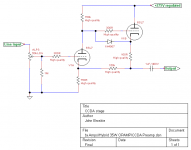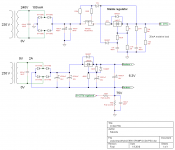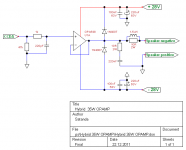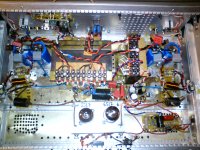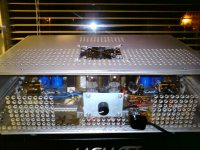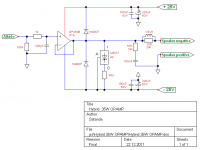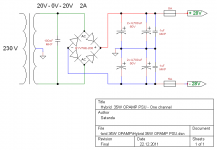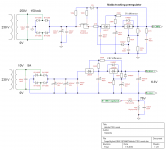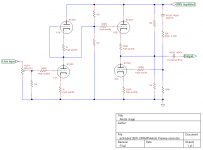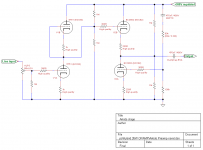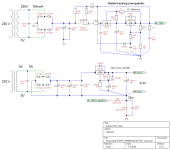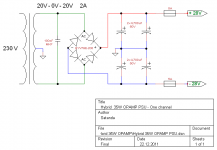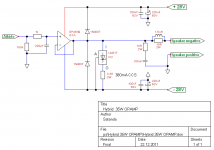*** LATEST SCHEMATICS ARE HERE *********************************
LINK: http://www.diyaudio.com/forums/tube...-hybrid-amplifier-35w-8ohm-2.html#post3418838
***********************************************************
Hi,
I have built tube / power opamp hybrid amplifier.
Tube preamp section is CCDA circuitry from John Broskie, which drives power opamp OPA548T connected as unity-gain voltage follower.
It sounds good, has that smoothness of tube and you can listen to the amplifier for long periods of time without any fatigue.
LINK: http://www.diyaudio.com/forums/tube...-hybrid-amplifier-35w-8ohm-2.html#post3418838
***********************************************************
Hi,
I have built tube / power opamp hybrid amplifier.
Tube preamp section is CCDA circuitry from John Broskie, which drives power opamp OPA548T connected as unity-gain voltage follower.
It sounds good, has that smoothness of tube and you can listen to the amplifier for long periods of time without any fatigue.
Attachments
Last edited:
Project update
I have updated few things. Mainly, I have changed preamp to aikido with noval tubes, because of better availability of ECC83 and ECC82 than 6SL7.
There are also some changes in the power supply and power amp.
Thinking about adding EQ, because some people really need one with their speakers/listening conditions.
I have updated few things. Mainly, I have changed preamp to aikido with noval tubes, because of better availability of ECC83 and ECC82 than 6SL7.
There are also some changes in the power supply and power amp.
Thinking about adding EQ, because some people really need one with their speakers/listening conditions.
Attachments
I am a little puzzled. Wouldn´t it be easier to lessen the feedback of the OPA548 to get 20dB gain instead of zero and skip the tube section?
Ofcourse you can do that. Then you have nice IC chip amplifier. But I want sound of tubes without output power tubes and output transformer.
Can´t see the difference. What you have is a tubepre capacitorcoupled to a 90dB feedbacked chip amp ;-).
There is difference in what will amplify voltage. Either tubes or transistors in chip, I prefer tubes for voltage amplification.
You still have 90dB raw gain in the chip. The amplification inside the chip does not lessen with more feedback. But if you lessen feedback, fidelity usully gets better.
In class AB without feedback around mosfet source follower you will have much more distortion. You could use class AB BJT follower output stage, but it should have about 4 to 5 pairs minimum of parallel devices to have small distortion and high damping factor.
Simple mosfet source follower works better in class A, which I don´t want because of so much heat.
Simple mosfet source follower works better in class A, which I don´t want because of so much heat.
Nice concept IMO, using a power op-amp in this way for the buffer function. If I had the time (I don't) I'd be tempted to build one myself just for fun. What's the purpose of the LM317 configured as a current sink on the output? I note that you added it in the second version, but I could not find a reason for it when I scanned the OPA458 data sheet.
LM317 constant current source makes OPA548 to stay in sinlge ended class A for first cca 0.5W. Simply it sounds better. It moves crossover to higher power levels.
Look at the bottom of the page at last schematics:
"http://www.tubecad.com/2004/blog0013.htm"
Look at the bottom of the page at last schematics:
"http://www.tubecad.com/2004/blog0013.htm"
Cool. Thanks for that. It makes sense. I see that JB's schematic shows the old LM12 - I remember those from many years back - not the first high power op-amp, but one of the first that was really usable for audio.
More power
I am thinking two options:
1) make LM3886 or TDA7294 unity-gain stable
2) OPA549 unity-gain in bridge mode configuration
Second should be doable, hopefully I can use CCS on output too woth bridge mode. BUT OPA549 is quite expensive, cca 25$. It is a lot money just for output stage. It should do about 150W into 8 Ohms. Nice thing about OPA549 is that you can current limit them with resistor, which should be usefull with bridge mode especially.
I am thinking two options:
1) make LM3886 or TDA7294 unity-gain stable
2) OPA549 unity-gain in bridge mode configuration
Second should be doable, hopefully I can use CCS on output too woth bridge mode. BUT OPA549 is quite expensive, cca 25$. It is a lot money just for output stage. It should do about 150W into 8 Ohms. Nice thing about OPA549 is that you can current limit them with resistor, which should be usefull with bridge mode especially.
I wish you can do Lm3886 since I also have 6 pcs of it to use..also LM3875 and Lm1876. If these chips can be stable as unity gain buffers..My plan before is to have a gain of 5 and the rest is from the tube pre...but not done yet hope you will...
I wish you can do Lm3886 since I also have 6 pcs of it to use..also LM3875 and Lm1876. If these chips can be stable as unity gain buffers..My plan before is to have a gain of 5 and the rest is from the tube pre...but not done yet hope you will...
I am trying LM3886 non-inverting mode at unity at this thread, but I need help with it:
http://www.diyaudio.com/forums/chip-amps/232233-lm3886-unity-gain.html
I suspect that with the shown Hybrid Amp schematic's series isolating 1 k and 220 pf to gnd the source impdance may be controlled enough to try the noise gain hack
the "sportiest" I would want to try with LM3886 would be to aim for noise gain of ~20 with asymptote/pole at 200kHz, which puts the low frequency zero at 10 kHz, I'd try noise gain R ~ 1kOhm
the "sportiest" I would want to try with LM3886 would be to aim for noise gain of ~20 with asymptote/pole at 200kHz, which puts the low frequency zero at 10 kHz, I'd try noise gain R ~ 1kOhm
Last edited:
- Status
- Not open for further replies.
- Home
- Amplifiers
- Tubes / Valves
- Simple hybrid amplifier (35W/8Ohm)
